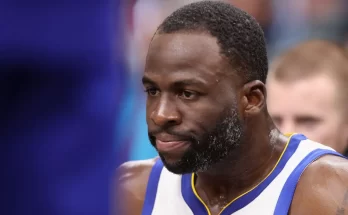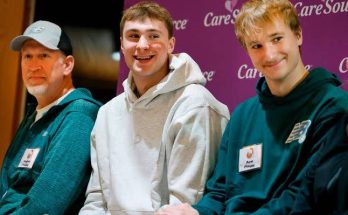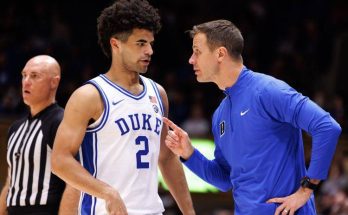From the moment he checked into the court, Koby Brea carried himself with the quiet confidence you’d expect from someone whose reputation precedes him. A former University of Kentucky Wildcat turned Phoenix Suns rookie, Brea didn’t just show up for his NBA Summer League debut—he made a statement. In a dazzling 19‑point performance on an incredibly efficient 7‑of‑10 shooting night, including 4‑of‑5 from beyond the arc, Brea lit up the stat sheet and opened eyes around the league .
Brea’s journey to this defining night was not the typical one. After transferring from Dayton to Kentucky, he spent just one season under head coach Mark Pope’s direction, becoming the first Wildcat drafted under Pope’s tenure . Despite the abbreviated UK career, he made an indelible impression—averaging around 12 points per game while shooting roughly 44% from deep and repeatedly delivering clutch scoring in high‑leverage situations. Notably, he dropped 23 points in an NCAA Tournament game against Illinois and drilled seven threes in a stunning upset win over Florida, the eventual national champions .
Draft night in June brought further significance to his trajectory. Taken 41st overall by Phoenix, Brea joined a franchise hungry for floor spacing after the departure of Kevin Durant, and where future Hall‑of‑Famer Devin Booker—himself a former Kentucky one‑and‑done—continues to anchor the franchise’s offensive identity . The Suns organization, recognizing Brea’s elite shooting stroke and mature shot selection, viewed him as a potential steal late in the second round whose skills fit seamlessly into their perimeter‑heavy offense and spacing needs .
So when that debut came in Las Vegas, there was a sense that Brea was ready—but even so, the efficiency, poise, and production exceeded expectations. He added three rebounds and a steal to his scoring line, anchoring a winning effort by the Suns in Summer League opener . From beyond the arc his release was deceptively quick and smooth; through the arc his demeanor was calm and unhurried—traits rare in rookies accustomed to tentative first outings.
As scouts circled, team officials drew connections between his college-specific preparation and NBA readiness. Brea’s Kentucky tenure, though brief, was high impact. Under Pope’s system emphasizing spacing, intelligence, and efficient shot selection, he flourished while proving mentally and physically durable—playing 30+ minutes in 16 games during his season at Kentucky, including 13 of the last 14 games of the year . For a second‑round pick, that’s the kind of reliability that draws league attention.
Phoenix’s front office praised the pick as a rare blend of readiness and upside. According to one GM’s post‑selection quote, Brea “understands his role, doesn’t shy away from the big moment, and brings an elite shooting ability that fits perfectly with how we play. He’s a worker” . Pair him with Booker, and suddenly the Suns have a tandem of former Wildcats with high basketball IQ and lethal perimeter touch.
Kentucky fans saw more continuity in Brea’s rise. His selection marked a new era under senior coach Mark Pope: a coach in his first year turning out not just wins but NBA-ready talent in record time. When the news broke that Kentucky had produced their first NBA draft pick under Pope, the reaction from Big Blue Nation was both celebratory and earned—they recognized what this pick meant for the program’s direction . Pope himself said: “I couldn’t be more proud of Koby. His work ethic, his leadership, and his ability to elevate our program set the tone for what we want to build,” further amplifying the symbolic weight of Brea’s ascent .
Back in Las Vegas, his outing signaled more than just stats. It projected traits—calm under pressure, disciplined timing, maturity beyond his years. He made scoring look effortless, never forcing a shot, yet always in rhythm. His rebounds and a steamrolled steal complemented the production—to scouts, those ancillary plays underscored readiness for NBA pace and intensity .
Between Brea’s drafting and Summer League debut, the narrative around him shifted quickly—from intriguing second‑round speculation to one of the summer’s must‑watch rookies. UK analysts highlighted his history: leading the nation in 3‑point percentage at Dayton, then continuing that elite efficiency at Kentucky; durability; clutch performance in tournament settings—all making him appear NBA primed from day one .
It wasn’t just about scoring. Brea’s shot selection reflected high hoop IQ. He knew when to step into a catch‑and‑shoot triple, when to go zone or pick up his dribble for a mid‑range pull‑up. That control belied his newcomer status. Moments into his Suns game, he already looked like a vet anchoring the second unit. That kind of demeanor is rare among second‑rounders, and made clear why coaches and executives had pegged him as a genuine steal in the draft—even if he slipped to 41 .
He didn’t do it alone. Teammates Ryan Dunn, Boogie Ellis, Khaman Maluach and others also had strong showings, but Brea’s night drew headlines—partly because of his narrative arc, partly the quality of the performance. Suns fans on social media quickly dubbed him “Koby ‘Fuego’ Brea,” celebrating his near‑perfect night from deep with catch‑phrase highlights .
Such early momentum matters. For a borderline roster player, strong Summer League showings on both ends of the floor can make the difference between being cut in training camp and making the opening roster. With his shooting ability, basketball IQ, and poise, Brea has positioned himself firmly on the right side of that divide.
For Kentucky fans, it’s added validation of a familiar pattern: from Calipari’s era to Pope’s first season, Kentucky continues to produce NBA contributors. And in Brea, there is a continuity of craft—versatility, shotmaking, readiness—that long defined the Wildcats’ legacy of forget‑the‑draft picks, forge the player.
Now, as Brea heads into the regular season preparation with the Suns, he’ll train alongside Booker, Beal (if he remains), and other veteran playmakers who will occupy defenders and open shots. Brea’s proven ability to hit from deep means defenses must respect him, creating space for others. That is true value no matter how few minutes he plays.
But perhaps most importantly, for Brea himself it’s proof of potential. He could have slipped. He could have faded into obscurity. Instead, he’s arriving in NBA camp with proof—documented, verified performances under bright lights, on both stage and scouting video. He’s carved out attention and defined expectations, and those expectations are measurable: reliable catch‑and‑shoot scoring, rotation readiness, defensive effort, and adaptability.
If he continues on this path—if he sustains efficiency, stays healthy, and continues improving—it’s not farfetched to imagine him carving a multi‑year NBA career as a valuable 3‑and‑D wing off the bench, much like current veterans who landed in the league via second round and built long runs with precision shooting and discipline.
In that sense, Sunday was more than just a game—it was a directional marker. It showed that Koby Brea is more than just a headline or a draft pick; he’s a player whose trajectory is trending upward, a player ready to contribute, and a player whose offseason rise reflects the skill‑development foundations laid at Kentucky under Pope.
With that summer debut behind him, attention will now shift to how he fares in camp, whether he earns a two‑way contract or full roster spot, and how he adapts to the regular season pace. But if history counts, his trajectory is aligned: from elite shooting in college, measurable development in Lexington, to efficient execution on a pro stage. At each stop, Brea has left little doubt.
Ultimately, his rise is about timing as much as talent. The Suns needed floor spacing. Kentucky needed its first NBA‑draft validation under Pope. Las Vegas needed breakout storylines. And for Brea, this was the moment to turn promise into proof.
He did. He delivered. And now, the next chapters begin—all because, on that night, the sharpshooter was simply on fire.


